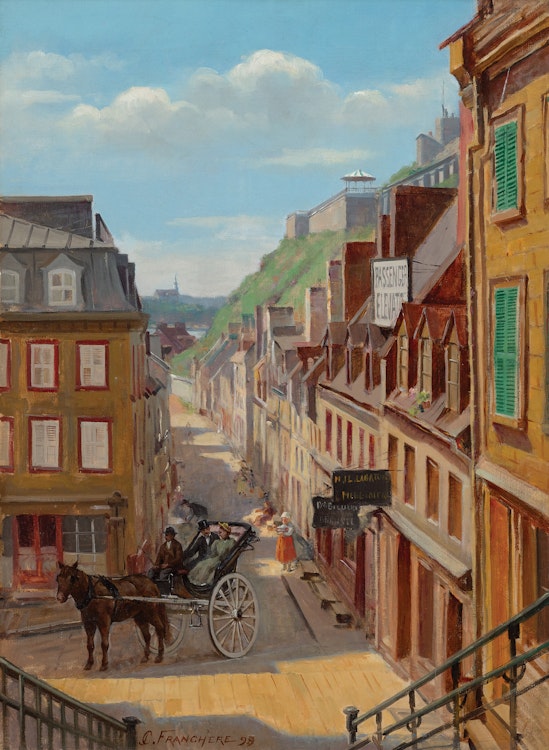La Fiacre, Rue Champlain, Quebec City by Joseph-Charles Franchère

Joseph-Charles Franchère
La Fiacre, Rue Champlain, Quebec City
oil on canvas
signed and dated 1899 lower left
23.25 x 17 ins ( 59.1 x 43.2 cms )
Auction Estimate: $4,000.00 - $6,000.00
Price Realized $14,400.00
Sale date: December 6th 2023
Walter Klinkhoff Gallery, Montreal
A.K. Prakash & Associates, Inc., Toronto
Victor Gordin, Toronto
A.K. Prakash & Associates, Inc., Toronto
Acquired by the present Private Collection, March 2001
A.K. Prakash, “Canadian Art‒Selected Masters from Private Collections”, Toronto, 2003, reproduced page 67
Painted by Franchère in 1899, “Le Fiacre” depicts Quebec City’s most charming street both then and now, Rue Champlain. Made of cobblestones and lined with historic stone buildings, it is one of North America’s oldest commercial streets. The title translates to "the cab", referring to the horse and carriage in the foreground that is transporting a well‒to‒do couple. Franchère depicts the famous downward‒sloping street from the base of the Escaliers Casse‒Cou (The Breakneck Stairs), the quintessential vantage point used for paintings and photographs in order to capture the charm of the area.
Shortly after “Le Fiacre” was completed, Franchère became an associate of the Royal Canadian Academy in 1902, exhibiting with the Art Association of Montreal, further cementing his standing in the milieu of Canadian artistic circles.
Share this item with your friends
Joseph-Charles Franchère
(1866 - 1921)
Born in Montreal, he studied with Joseph Chabert at the Institut national des Beaux-Arts, Montreal; with F.E. Meloche at Council of Arts and Manufactures, Montreal (c. 1887-88); with Jean-Léon Gérôme and Joseph Blanc at the Ecole des Beaux-Arts, Paris (1888-92); Académie Julian and Académie Colarossi, Paris.
Evidence of his mastery of portrait painting can be seen in his self-portrait (1894), in the coll. of Musée du Québec. He won three honourable mentions at the Ecole des Beaux-Arts in Paris and two first prize medals as a student at evening shows in Paris. On his return to Montreal, he opened a studio and painted many portraits and religious murals. He also did landscapes, figure and genre paintings. He painted scenes in oil on board, oil on card, water colour and pastel. The National Gallery or Canada has four works by him: a study for a religious painting, a study of a plaster head of a woman, a rural genre scene, and a dancer with a tambourine, which provide a sampling of his subject matter. He painted in Quebec, Ontario, France, Belgium, Venice, Scotland and elsewhere.
He died in Montreal at the age of 55.
Literature Source:
"A Dictionary of Canadian Artists, Volume 1: A-F, 5th Edition, Revised and Expanded", compiled by Colin S. MacDonald, Canadian Paperbacks Publishing Ltd, Ottawa, 1997

